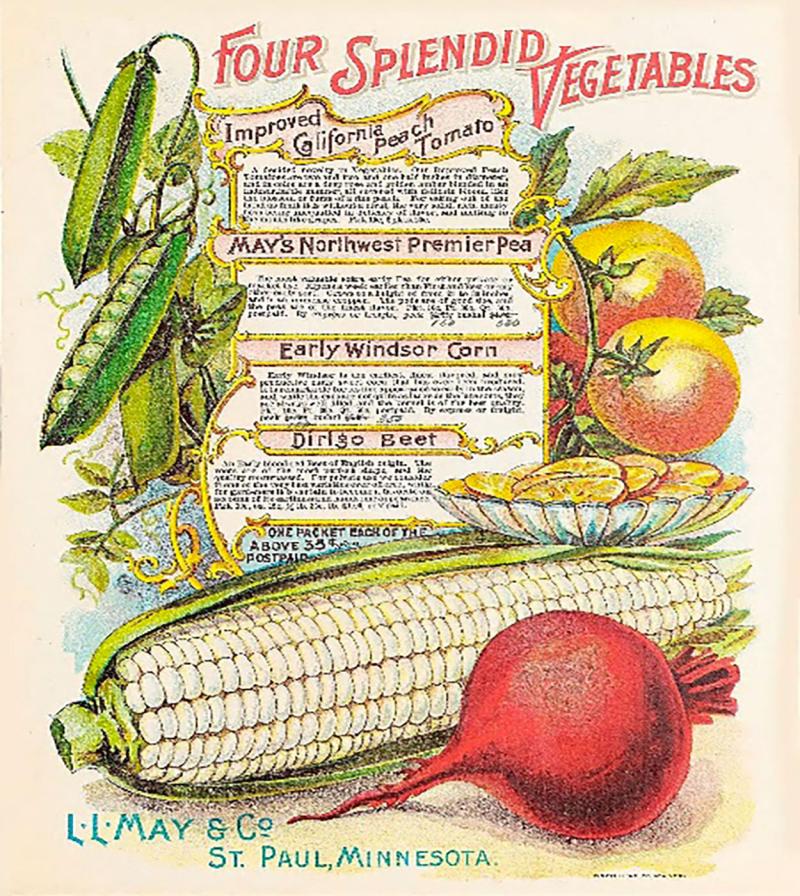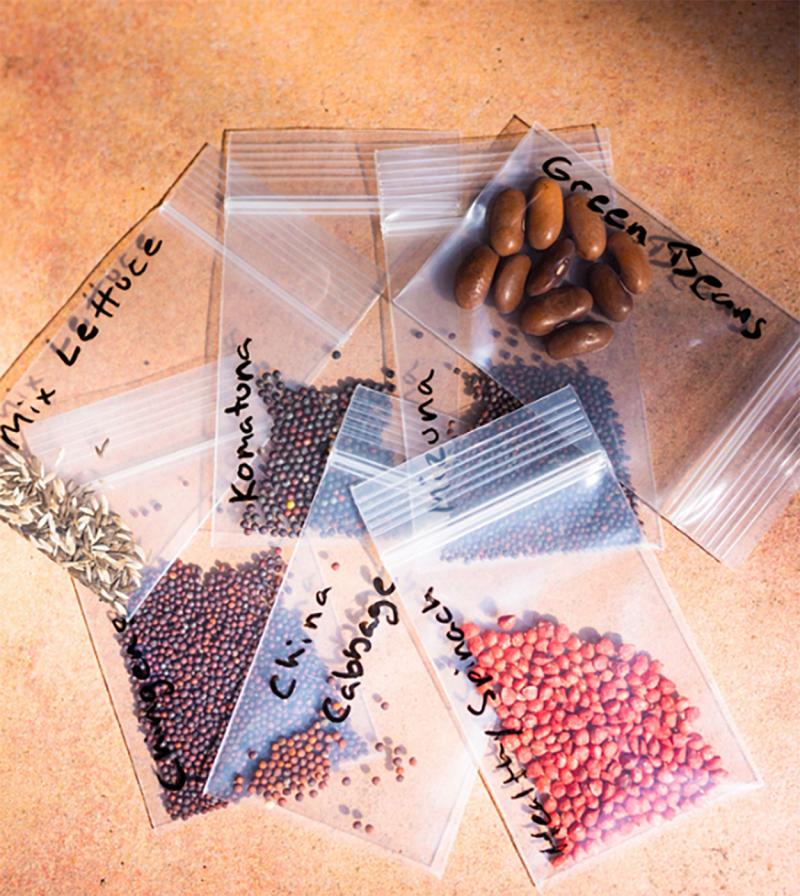Written by Sheila Hillberry, SDSU Extension Master Gardener volunteer, under the direction and review of Prairey Walkling; Kristine Lang; Rhoda Burrows, former Professor & SDSU Extension Horticulture Specialist; and Vaughn Reints.
After seed starting, or at the end of the growing season, many gardeners find themselves with partially full seed packets. Do not throw these seeds away, as most will last more than a year after the “sell by” date. Some seeds will keep 10 years (or more!) if carefully stored. Below are some recommendations for how to store your garden seeds to keep them viable for use again next season. In addition, learn about some of the issues with vigor that you may see when using old seeds.
Seed Storage Tips

Here are some tips to extend the life of seeds:
- Reducing humidity is the most-important factor in extending the life of seeds. In general, relative humidity below 60% is best for seed storage. Avoid storing seeds in sheds or garages where they may be exposed to high humidity in the summer.
- Store your seeds in a cool, dry location away from direct sunlight. Exposure to temperatures above 90 degrees Fahrenheit will greatly decrease the viability of your seed for future planting seasons.
- Seeds can be stored in sealed containers, plastic bags, and wax or paper envelopes. When seeds are stored in sealed containers, ensure that moisture is not trapped within the container; if you see condensation forming inside the jar or container, you may have issues.
- A refrigerator can be a good option for seed storage that can extend the storage life by several years. Seeds stored in the refrigerator should be in a sealed container. When seeds are removed from cold storage, let the container reach room temperature before opening the container to avoid condensation on the seeds within the container.
- If you have grown and harvested seeds yourself, make sure that they are thoroughly dry before storing the saved seeds.
- If you want to check for viability before planting, do a germination test.
Expected Storage Life
Different seeds have different expected shelf life, even with the best conditions. Parsnips are notoriously short-lived seeds. Tomatoes, lettuce, beans and peas benefit most from careful handling. Keep in mind that the older the seed, the lower the germination and vigor. For this reason, some choose to mix in new seed with the old when direct seeding or seed at a higher rate to account for a reduced percentage of plants that may germinate after several years of storage. Time is precious in our South Dakota growing season, and no one wants to end up short on their favorite flowers or vegetables!
Seeds have greater longevity than you may think. With proper storage, you can often successfully utilize commercial seeds for several years beyond the “sell by” date. This allows you to save money by not purchasing new seed every year, and it also allows you to hang onto your favorite varieties in the event there are issues with availability in the following season. Below are the expected storage life of several popular vegetable seeds when stored properly.
Things to Consider

When making the choice to use old seed, there are considerations one should make, especially if concerned with profit. Seed vigor is essential for the successful cultivation of vegetable crops, influencing everything from germination rates to overall plant health and crop yield. A plant grown from old seed can be affected throughout its lifecycle. Fresh seeds generally exhibit higher vigor compared to carryover seeds, which can suffer from reduced germination rates and increased disease susceptibility if stored for too long. These issues underline the importance of proper seed storage and the timely use of seeds. High seed vigor ensures rapid, uniform emergence and development across a variety of field conditions, leading to a robust and even crop stand.
- Delayed Germination and Emergence: Seeds with low vigor take longer to germinate, resulting in uneven crop stands and making the plants more vulnerable to weed interference. Seedlings are often smaller plants that take longer to get established.
- Increased Disease Susceptibility: Weaker seeds are more likely to contract soil pathogens, leading to greater occurrences of seed rot and seedling blights, which thin out stands and reduce plant productivity.
- Reduced Stress Tolerance: Seeds that lack vigor are less capable of withstanding environmental stresses, such as cold or wet conditions, leading to poor seedling growth and development and, consequently, reduced crop uniformity and yield.
- Economic Impact: The use of low-vigor seeds can lead to higher agricultural costs due to the need for increased seeding rates to achieve desired stand densities, as well as elevated expenditures on pesticides and fungicides to combat the increased pest and disease pressures. This ultimately results in lower yields and diminished profits.
Ensuring high seed vigor through meticulous selection and testing is critical for maximizing productivity and achieving high-quality crops. Proper management practices are vital for maintaining seed health and vigor, thereby enhancing the overall efficiency and output of agricultural operations. For most backyard gardeners, using old seed is not a deal breaker, but some scenarios may end in disappointment.
Shelf Life by Variety
Below is the expected storage life of several popular vegetable seeds when stored properly.
2 Years
- Corn
- Lettuce
- Okra
- Onion
- Parsley
- Parsnip
- Pepper
3 Years
- Bean
- Broccoli
- Carrots
- Celery
- Kohlrabi
- Peas
- Spinach
4 Years
- Beet
- Cabbage
- Fennel
- Kale
- Mustard
- Pumpkin
- Rutabaga
- Squash
- Swiss chard
- Tomato
- Turnip
- Watermelon
5 Years
- Brussel sprouts
- Collards
- Cucumber
- Endive
- Muskmelon
- Radish
References and Resources
- Buttal, L. and S. Siegel. 2015. The Seed Garden: The Art and Practice of Seed Saving. Seeds Savers Exchange, Inc. Decorah, IA.
- Ells, J.E., L.N. Bass, and D. Whiting. 2020. Storing Vegetable and Flower Seeds. Colorado State University Extension.
- Gough, R. and C. Moore-Gough. 2011. The Complete Guide to Saving Seeds: 322 Vegetables, Herbs, Flowers, Fruits, Trees, and Shrubs. Storey Publishing. North Adams, MA.
- Steil, A. 2023. How to Store Seeds and Test Germination Rates. Iowa State University Extension and Outreach.
- Oregon State University. Seed Lab- Importance of Seed Vigor.
- Johnson, Gordon and Ernest, Emmalea Garver. 2016 Poor Stands or Stand Loss Due to Poor Seed or Plant Quality, Revisited. University of Delaware Extension


